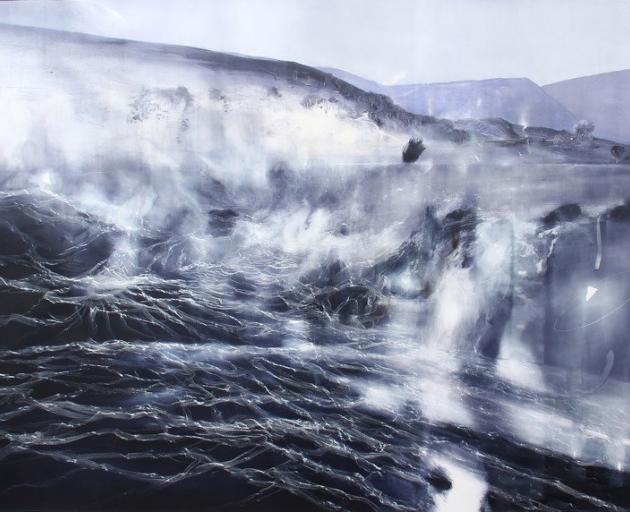In this week's Art Seen, Laura Elliott looks at exhibitions from Garry Currin, Mark Mitchell, and Nigel Wilson.
 Small Portions of the Eternal World, by Garry Currin
Small Portions of the Eternal World, by Garry Currin

''The Light of One Day'', Garry Currin (Milford Galleries, Queenstown)
Garry Currin is a premier artist of dreamscapes, dramatic landscapes that draw on elements of the natural world and the fantastical. His latest exhibition plays with the effects of changing light as it glances off turbulent water and filters through cloud and smoke, creating a perpetual sense of motion.
Moving closer to the picture, the smoky impression of the individual brushstrokes become more apparent, almost blurring the vision. There is a slight weathering effect to the surface of the works, as if the destructive, elemental clash within has begun to erode even the paint itself.
There is a fascinating collision in Currin's paintings between technique and subject matter. The soft, hazy palette could evoke that idea of an insubstantial dream, but there is nothing gentle and elusive about the scenes he immortalises on canvas. Waves break with violent force, water reflects the glow of spreading fire like lava erupting from a volcano, the entire world seems to erupt into post-apocalyptic chaos.
In Conversations with the Moon III, the moon is a barely visible slice in the sky, an apparently harmless presence hiding behind cloud; yet in the water far below, the pull of the tide is a remorseless, dangerous whirlpool.
Small Portions of the Eternal World and The Sea of Storms are likewise daunting images of a world in which humans have no presence or power, where nature reigns, a relentless, unstoppable force.
 Gilt I, by Mark Mitchell
''Trig'', Mark Mitchell (Milford Galleries, Queenstown)
Gilt I, by Mark Mitchell
''Trig'', Mark Mitchell (Milford Galleries, Queenstown)

Mark Mitchell's beautiful unique vessels challenge the idea that perfection in ceramic art relies on regular form and consistent pattern. The exhibition title ''Trig'', with its mathematical connotation, suggests precision and rationality, but while there is a definite geometrical theme to Mitchell's surface decoration, there is also a deliberate deviation from uniform design and structure - a hint of chaos where the eye and mind expect order.
Each piece is aptly titled: Seed and Submerge respectively speak of being engulfed in thick tropical forest or the depths of the ocean; the slanting tiled pattern of Bias teases the eye to pick a side and focus on either white shapes or blue; the radiating, interlocked triangles of Scope create an illusion of depth, pulling the eyes up or down, depending on whether you fix on the upturned or downturned triangles.
Where there is an even pattern, on works such as Gilt I and Gilt II, the shape of the vessel itself is warped, as if someone has come along and pushed their hands into the sides while it was still malleable and vulnerable. Conversely, where there are smooth surfaces and flat planes, it is the ornamental design that alters in size, sits slightly off-centre, or is randomly interrupted by a strike of colour. It's a juxtaposition of painstaking symmetry and playful irregularity that works to striking effect.
 Shag Point, by Nigel Wilson.
''Coastlines'', Nigel Wilson (Hullabaloo Art Space, Cromwell)
Shag Point, by Nigel Wilson.
''Coastlines'', Nigel Wilson (Hullabaloo Art Space, Cromwell)

Nigel Wilson's impressionistic landscapes have a unique ability to connect with all the senses, teasing at memories and evoking sights, sounds, and even smells of a particular place and time, engaging the viewers' participation in what they are seeing and how they interpret it, rather than merely presenting a fixed image.
His current solo show ''Coastlines'' focuses on the shores and hills of the Southern coast, and manages to convey a sense of timelessness and of constant change.
The notion of an eternal, wild land comes across strongly; this could be New Zealand today, or the land and waters that were traversed by our ancestors in centuries past, or the terrain that will carry the footsteps of future generations in decades to come.
However, the energy and movement conveyed by the rough brushstrokes and vigorous application of colour also suggests the rapidity of time passing, waves breaking, earth eroding, the indomitable cycle of destruction and evolution.
Shag Point is the only large-scale oil painting in the collection, the most representative of Wilson's traditional style. In something of a departure, most of the works are acrylics on paper, and introduce a more painterly approach.
Each piece acts as a map of Wilson's movements, with paint left to drip organically where it falls, layers and scratches and drawn lines slashing across the surface, the artist fully engulfed in the experience of translating impression and memory into visual form.
-By Laura Elliott








![Untitled (c. mid 1990s, [pink 3]), by Martin Thompson, 415mm×590mm. Photo: courtesy of Brett...](https://www.odt.co.nz/sites/default/files/styles/odt_landscape_small_related_stories/public/story/2024/02/untitled_pink_3.jpg?itok=Q0aQrc9o)



